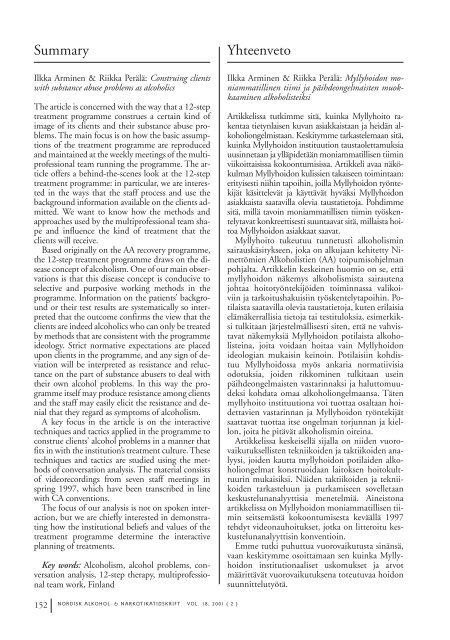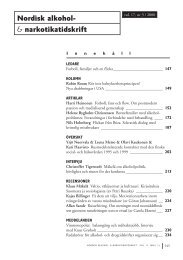I nneh å ll
I nneh å ll
I nneh å ll
Create successful ePaper yourself
Turn your PDF publications into a flip-book with our unique Google optimized e-Paper software.
Summary<br />
Ilkka Arminen & Riikka Perälä: Construing clients<br />
with substance abuse problems as alcoholics<br />
The article is concerned with the way that a 12-step<br />
treatment programme construes a certain kind of<br />
image of its clients and their substance abuse problems.<br />
The main focus is on how the basic assumptions<br />
of the treatment programme are reproduced<br />
and maintained at the weekly meetings of the multiprofessional<br />
team running the programme. The article<br />
offers a behind-the-scenes look at the 12-step<br />
treatment programme: in particular, we are interested<br />
in the ways that the staff process and use the<br />
background information available on the clients admitted.<br />
We want to know how the methods and<br />
approaches used by the multiprofessional team shape<br />
and influence the kind of treatment that the<br />
clients wi<strong>ll</strong> receive.<br />
Based origina<strong>ll</strong>y on the AA recovery programme,<br />
the 12-step treatment programme draws on the disease<br />
concept of alcoholism. One of our main observations<br />
is that this disease concept is conducive to<br />
selective and purposive working methods in the<br />
programme. Information on the patients’ background<br />
or their test results are systematica<strong>ll</strong>y so interpreted<br />
that the outcome confirms the view that the<br />
clients are indeed alcoholics who can only be treated<br />
by methods that are consistent with the programme<br />
ideology. Strict normative expectations are placed<br />
upon clients in the programme, and any sign of deviation<br />
wi<strong>ll</strong> be interpreted as resistance and reluctance<br />
on the part of substance abusers to deal with<br />
their own alcohol problems. In this way the programme<br />
itself may produce resistance among clients<br />
and the staff may easily elicit the resistance and denial<br />
that they regard as symptoms of alcoholism.<br />
A key focus in the article is on the interactive<br />
techniques and tactics applied in the programme to<br />
construe clients’ alcohol problems in a manner that<br />
fits in with the institution’s treatment culture. These<br />
techniques and tactics are studied using the methods<br />
of conversation analysis. The material consists<br />
of videorecordings from seven staff meetings in<br />
spring 1997, which have been transcribed in line<br />
with CA conventions.<br />
The focus of our analysis is not on spoken interaction,<br />
but we are chiefly interested in demonstrating<br />
how the institutional beliefs and values of the<br />
treatment programme determine the interactive<br />
planning of treatments.<br />
Key words: Alcoholism, alcohol problems, conversation<br />
analysis, 12-step therapy, multiprofessional<br />
team work, Finland<br />
152 NORDISK ALKOHOL- & NARKOTIKATIDSKRIFT VOL. 18, 2001 ( 2 )<br />
Yhteenveto<br />
Ilkka Arminen & Riikka Perälä: My<strong>ll</strong>yhoidon moniammati<strong>ll</strong>inen<br />
tiimi ja päihdeongelmaisten muokkaaminen<br />
alkoholisteiksi<br />
Artikkelissa tutkimme sitä, kuinka My<strong>ll</strong>yhoito rakentaa<br />
tietynlaisen kuvan asiakkaistaan ja heidän alkoholiongelmistaan.<br />
Keskitymme tarkastelemaan sitä,<br />
kuinka My<strong>ll</strong>yhoidon instituution taustaolettamuksia<br />
uusinnetaan ja y<strong>ll</strong>äpidetään moniammati<strong>ll</strong>isen tiimin<br />
viikoittaisissa kokoontumisissa. Artikkeli avaa näkökulman<br />
My<strong>ll</strong>yhoidon kulissien takaiseen toimintaan:<br />
erityisesti niihin tapoihin, joi<strong>ll</strong>a My<strong>ll</strong>yhoidon työntekijät<br />
käsittelevät ja käyttävät hyväksi My<strong>ll</strong>yhoidon<br />
asiakkaista saatavi<strong>ll</strong>a olevia taustatietoja. Pohdimme<br />
sitä, mi<strong>ll</strong>ä tavoin moniammati<strong>ll</strong>isen tiimin työskentelytavat<br />
konkreettisesti suuntaavat sitä, mi<strong>ll</strong>aista hoitoa<br />
My<strong>ll</strong>yhoidon asiakkaat saavat.<br />
My<strong>ll</strong>yhoito tukeutuu tunnetusti alkoholismin<br />
sairauskäsitykseen, joka on alkujaan kehitetty Nimettömien<br />
Alkoholistien (AA) toipumisohjelman<br />
pohjalta. Artikkelin keskeinen huomio on se, että<br />
my<strong>ll</strong>yhoidon näkemys alkoholismista sairautena<br />
johtaa hoitotyöntekijöiden toiminnassa valikoiviin<br />
ja tarkoitushakuisiin työskentelytapoihin. Potilaista<br />
saatavi<strong>ll</strong>a olevia taustatietoja, kuten erilaisia<br />
elämäkerra<strong>ll</strong>isia tietoja tai testituloksia, esimerkiksi<br />
tulkitaan järjestelmä<strong>ll</strong>isesti siten, että ne vahvistavat<br />
näkemyksiä My<strong>ll</strong>yhoidon potilaista alkoholisteina,<br />
joita voidaan hoitaa vain My<strong>ll</strong>yhoidon<br />
ideologian mukaisin keinoin. Potilaisiin kohdistuu<br />
My<strong>ll</strong>yhoidossa myös ankaria normatiivisia<br />
odotuksia, joiden rikkominen tulkitaan usein<br />
päihdeongelmaisten vastarinnaksi ja haluttomuudeksi<br />
kohdata omaa alkoholiongelmaansa. Täten<br />
my<strong>ll</strong>yhoito instituutiona voi tuottaa osaltaan hoidettavien<br />
vastarinnan ja My<strong>ll</strong>yhoidon työntekijät<br />
saattavat tuottaa itse ongelman torjunnan ja kie<strong>ll</strong>on,<br />
joita he pitävät alkoholismin oireina.<br />
Artikkelissa keskeise<strong>ll</strong>ä sija<strong>ll</strong>a on niiden vuorovaikutukse<strong>ll</strong>isten<br />
tekniikoiden ja taktiikoiden analyysi,<br />
joiden kautta my<strong>ll</strong>yhoidon potilaiden alkoholiongelmat<br />
konstruoidaan laitoksen hoitokulttuurin<br />
mukaisiksi. Näiden taktiikoiden ja tekniikoiden<br />
tarkasteluun ja purkamiseen sove<strong>ll</strong>etaan<br />
keskustelunanalyyttisia menetelmiä. Aineistona<br />
artikkelissa on My<strong>ll</strong>yhoidon moniammati<strong>ll</strong>isen tiimin<br />
seitsemästä kokoontumisesta kevää<strong>ll</strong>ä 1997<br />
tehdyt videonauhoitukset, jotka on litteroitu keskustelunanalyyttisin<br />
konventioin.<br />
Emme tutki puhuttua vuorovaikutusta sinänsä,<br />
vaan keskitymme osoittamaan sen kuinka My<strong>ll</strong>yhoidon<br />
institutionaaliset uskomukset ja arvot<br />
määrittävät vuorovaikutuksena toteutuvaa hoidon<br />
suunnittelutyötä.



